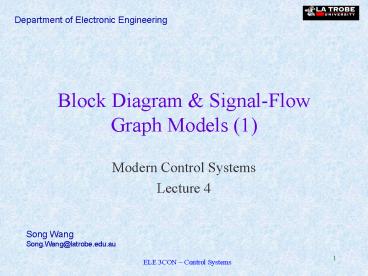Block Diagram - PowerPoint PPT Presentation
1 / 16
Title:
Block Diagram
Description:
Moving a pickoff point ahead of a block. Moving a summing point ahead of a block ... Step 1. Move the pickoff point after G4. 10. ELE 3CON Control Systems. Lecture 4 ... – PowerPoint PPT presentation
Number of Views:2968
Avg rating:3.0/5.0
Title: Block Diagram
1
Block Diagram Signal-Flow Graph Models (1)
- Modern Control Systems
- Lecture 4
2
Outline
- Block diagram representation
- Block diagram reduction
- Signal-flow graph
- Masons gain formula
3
Block diagram representation
- The dynamic systems that comprise automatic
control systems are represented by a set of
simultaneous differential equations. - The Laplace transform converts linear
differential equations into algebraic equations
in terms of variable s. - The transfer function of a linear system is
defined as the ratio of the Laplace transform of
the output variable to the Laplace transform of
the input variable, assuming zero initial
conditions.
In control systems, controlled variables are
related to controlling variables by transfer
function, which depicts the input-output
relationship. In order to show this input-output
relationship by graphical means, we commonly use
block diagram representation.
4
Block diagrams consist of unidirectional,
operational blocks that represent the transfer
function of the variables of interest.
- For example, for a field-controlled DC motor and
load, the relationship between the displacement
?(s) and the input voltage Vf(s) is shown by - In contrast to a purely abstract, mathematical
representation, a block diagram indicates more
realistically the signal flows of the actual
system.
5
A system may have several variables under
control. For example, a 2-input 2-output system
is described by
We write this in matrix form
The block diagram representation is
6
Derivation of the closed-loop transfer function
(CLTF)
When H(s)1, it is called unity feedback.
When G(s)H(s)gtgt1, C(s)/R(s)1/H(s)
7
Consider again the following closed-loop system.
- What is the transfer function E(s)/R(s)?
- Closed-loop systems are used as they allow the
system performance to be dominated by the
components in the feedback path. This is an
important consideration as some components in the
forward path are outside designers control.
8
Block diagram reduction
- Cascading blocks
- Moving a summing point after a block
- Moving a pickoff point ahead of a block
- Moving a pickoff point after a block
- Moving a summing point ahead of a block
- Feedback loop elimination
9
Example a multiple-loop feedback control system
Step 1. Move the pickoff point after G4
10
Step 2. Eliminate loop G3G4H1
Loop L
Step 3. Eliminate loop L
Loop M
Step 4. Eliminate loop M
11
Signal-flow graph
- Alternative method to block diagram
representation, developed by S.J.Mason. - Advantage the availability of a flow graph gain
formula, also called Masons gain formula. - A signal-flow graph consists of a network in
which nodes are connected by directed branches. - It depicts the flow of signals from one point of
a system to another and gives the relationships
among the signals. Note that the signal flows in
only one direction.
12
Definitions
- Node - a point representing a signal or variable.
- Branch unidirectional line segment joining two
nodes. - Path a branch or a continuous sequence of
branches that can be traversed from one node to
another node. - Loop a closed path that originates and
terminates on the same node and along the path no
node is met twice. - Nontouching loops two loops are said to be
nontouching if they do not have a common node.
13
The signal flow graph is a pictorial method of
writing a set of algebraic equations to indicate
the interdependencies of variables.
Corresponding block diagram
Signal-flow graph of interconnected system
For example,
Signal-flow graph of two algebraic equations
14
Masons gain formula The linear dependence Tij
between the independent variable xi (also called
the input variable) and a dependent variable xj is
15
Write the gain formula in a simplified form
- Systematic approach
- Calculate forward path transfer function Pk for
each forward path k - Calculate all loop transfer functions
- Consider nontouching loops 2 at a time
- Consider nontouching loops 3 at a time
- etc
- Calculate ? from steps 2,3,4 and 5
- Calculate ?k as portion of ? not touching forward
path k
16
- Consider a two-path signal-flow graph.
- Calculate forward path transfer function Pk for
each forward path k. - Calculate all loop TFs.
- Consider nontouching loops 2 at a time.
- Loops L1 and L2 do not touch Loops L3 and L4.
- Consider nontouching loops 3 at a time.
- None.
- Calculate ? from steps 2,3,4.
- Calculate ?k as portion of ? not touching forward
path k. - The TF of the system is































